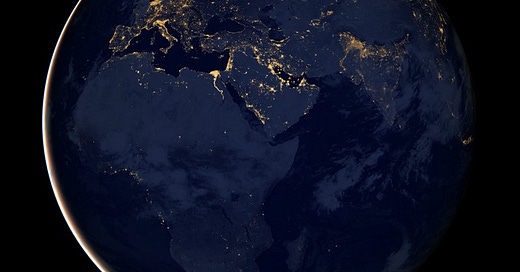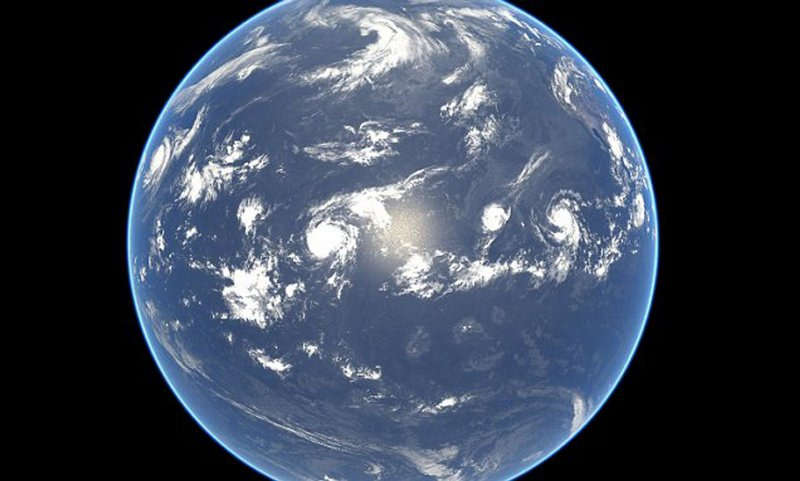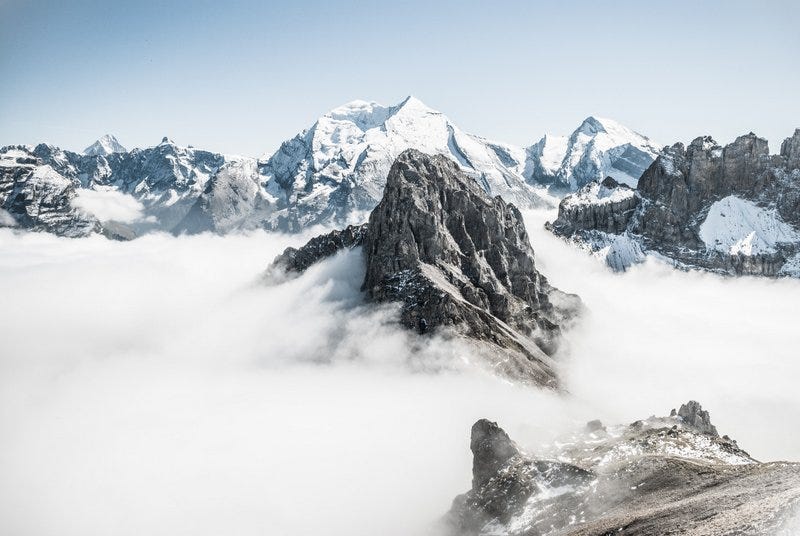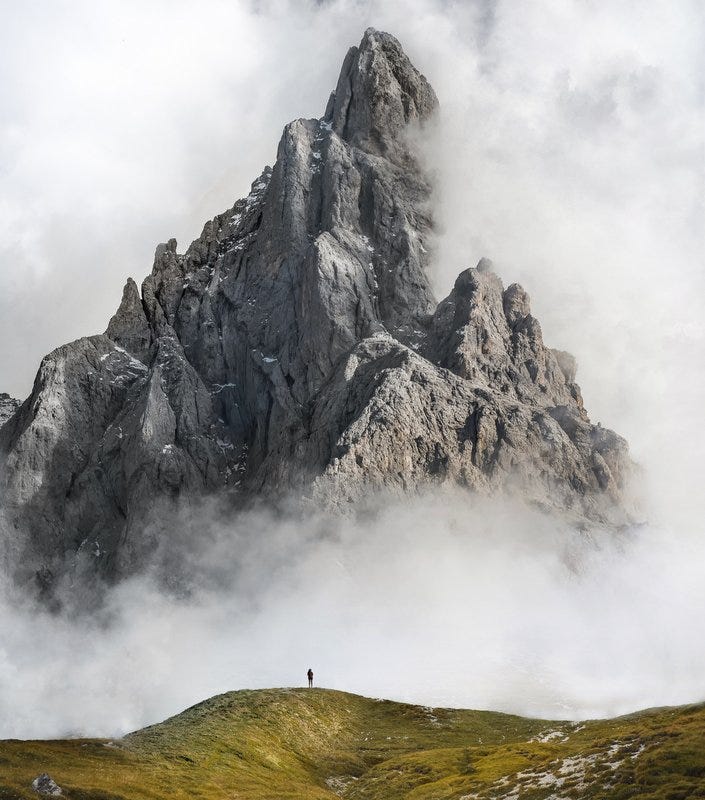Hello! Welcome to Everything Is Amazing, a newsletter about curiosity, attention and wonder - and about what you can learn by turning your maps the wrong way round.
Since something absolutely ridiculous happened on Twitter last week, there are around - gulp - 6,000 more of you reading than the last time I sent out a newsletter. (Hello! No, it’s fine, I always look this wild-eyed and freaked out. I just have that kind of face.)
So with that in mind, here’s a reintroduction to how things work around here.
Everything Is Amazing is delivered in seasons, like a TV show. I spent maybe 8-10 weeks blundering into your Inbox once or twice a week, then I take a short break to go for a few walks, eat an actual meal, remind friends & loved ones what I actually look like and so on.
That rest-time is what I’ve been doing for the last week or so, since the previous season wrapped. (Here’s a summary of everything we covered in Season 3, with the main theme being visual & optical illusions.)
During this downtime, I talked to this completely delightful food writer about my favourite tearoom in York:
(I’ve been really worried about Bettys these last few years - pandemical times have been tough on the tearooms of the UK - but I saw it just had its best Christmas period in its entire 102-year history, so my heart is eased.)
Then I completely failed to have a relaxing camping adventure - the Scottish weather’s been what old-timey writers would call “inclement” - but was lucky enough to be one of the few folk looking upwards when this meteor burned a trail of green fire across the UK skies. Hell of a thing.
Then there’s my viral Twitter thread from last week. To all you newcomers: if you like my Twitter posts, I hope you’ll be only slightly disappointed by this newsletter, which has more actual facts but takes far longer to get to the point.
So, that’s the story to date.
Now it’s time to look ahead.
In Search Of A World We Never See
This is my side of the planet we all live on.
I know I’m rather biased here, but - isn’t it gorgeous? Just look at it. What an unfathomably beautiful sight.
It’s a still from ‘Blue Marble: Next Generation,’ a mosaic of a year’s worth of observations from NASA’s Terra satellite - and a sequel to one of the most profound photographs ever taken, the image of the Earth snapped in 1972 by the crew of Apollo 17 as they hurtled towards the Moon.
If you’re eager for a proper “WOW” moment that you can feel all the way down to your boots, go to the official Blue Marble images page and download one of the enormously-high-resolution images. Open it, full-size it, and just scroll around for a while. Allow yourself to stravaig (a Scottish word meaning “to wander about aimlessly”) and Feel Some Really Big Things.
We really do live on a work of Fine Art, do we not?
And there is so much to see down there, so much to experience and feel part of - and yet, alas, this is the tragedy of living a finite human life, because we’re only going to catch the tiniest glimpse of everything that’s on offer on our planet - which is only one of an estimated 100 billion (perhaps many more) that our galaxy contains…
But wait. Let’s stop a second.
What do you actually see when you look at these images? What are you really, truly looking at?
If you’re like me, your eye is caught by the lights of cities in the nightside views, by the streaks and whorls of the weather, by the colours of the sunlit land against that rich, blue backdrop of the ocean…
Most of all, you see a planet made fascinating and beautiful by everything above sea-level.
In one sense, this is a natural consequence of the medium - these visible-light images aren’t showing you what’s under the ocean. But also, it’s about what your brain is doing. It’s selecting. You were born to filter out most of the blue here, or at least consign it to the role of a less consequential backdrop. The sea is just an also-there thing. The continents are where the real fun is!
But here’s the startling thing: most of the surface of our planet is covered with water. About 71%, to be precise. More than two-thirds of our homeworld is waterbound.
In fact, from the right camera angle, the land we live on - containing the most visible traces of our own existence - can almost completely vanish from view.
We live on an ocean world - and for the most part, we have no idea what’s down there.
(This image, while factually correct, is a little deceptive: scientists have mapped all the sea floors of the Earth, just not in anywhere near the kind of detail that makes sense at a human scale.)
Because of how we’ve adapted to live in the open air, we’re biased to fixate on that remaining 29%, and to consider it the most important thing for us to learn about. And in doing so, in tuning out the primary defining feature of the surface of our planet - exactly how much are we missing here?
Oceanographer Gene Feldman puts it like this:
“Earth is really an ocean planet. Life on land exists in this thin layer that begins a few feet below the surface of the soil and extends up into the tops of the trees. But in the ocean, life is found all the way from the surface to the very bottom of the deepest part. The deepest part of the ocean is nearly seven-and-a-half miles down. Because of this, the oceans contain 99 percent of the living space on the planet.”
Yet still we fixate on the land side of things. I mean, just look at the name we’ve given our planet. Shouldn’t it really be called “the Sea?”
From around 2009 to 2015, I had the very good fortune to hang out with a lot of professional travel writers - at conferences, in pubs and bars, and occasionally in the gutter. (Don’t judge! Travel writing is hard.)
Almost everyone I met was driven by an infectious passion to see the world, a maddening thirst that could never be slaked. To them, nowhere was ever “done” - as in yeah I’ve done Greece, meh, too hot - and their motivations were constantly at war between a longing to get to know familiar places even better and being haunted by everywhere they hadn’t yet seen.
It was their job to see the world and write about it - and yet “the world” usually meant everything apart from the sea, which was just the thing that they had to cross, the thing that inconveniently got in the way.
Most of us think like this. Because of course we do. We grew up this way. Like the citizens of Besžel and Ul Qoma in the story that began this newsletter last year, we have learned to unsee the 71% of the surface of our planet that’s least hospitable and accessible to us.
Most of us have, anyway. This doesn’t include the sailors, the marine biologists, the amateur scuba divers, the aquatic veterinarians, the ocean engineers - all of them holding all sorts of fascinating perspectives that have to fight to make a dent on our terrestrial bias.
So for this season of Everything Is Amazing, I’m challenging my own landbound gaze, and seeing what I can learn about that other 71% - starting in a few days with one of the most cataclysmic events in the history of the Mediterranean.
Those of you who saw my absurdly viral Twitter thread last Thursday (it reached 8 million people) will know a little about this already - but I hope I’ll still have a few surprises for you. And for those that didn’t? Hooray! I’m jealous. I would love to learn this story for the first time all over again.
It’s going to be a fairly breezy overview of this whole topic, mainly because I’m not an ocean scientist or even a science journalist, I’m just an idiot with a newsletter. But I’ll be linking to the true experts as I go, trying to avoid mangling their findings too much - and hopefully I’ll send you down a few rabbit-holes (what’s the oceanic equivalent of a rabbit-hole?) that you never knew existed.
That’s what we’re diving into. I hope you’re as excited as I am about it.
A Sublime Reading Experience
Last year I wrote about Paul “Double Rainbow” Vasquez, the modern world’s patron saint of awe - that delicious, unnerving cocktail of reverence, fear and (as travel writer Henry Wismayer brilliantly puts it) “humbling incomprehension” that yanks you out of your complacent anthropocentric certainty that you understand exactly how the world works.
As Henry notes in his recent New York Times piece, the scientific study of awe is relatively new - but it’s underpinned by a philosophical concept that goes back at least 1,800 years (at least in Western literature, anyway). It’s called the sublime - and it’s that mix of pure exhilaration and bubbling terror that you feel when you reach the top of a mountain and see that there’s nothing on all sides of you except an incredible view you’ll remember forever and a terrible drop you’re immediately eager to forget.
You feel the sublime in the way you breathe, in a dramatic lurch in your stomach & perhaps in lower parts, and in the way your knees suddenly seem unfit for purpose. A joyous lifting of the soul, and a terrible casting-down of the body, all at once. It’s just a lot. And it leaves you marked for the rest of your life.
In 1757, philosopher Edmund Burke attempted to pin down this nebulous but important idea in a treatise called A Philosophical Enquiry into the Origin of Our Ideas of the Sublime and Beautiful.
In his 2003 book Mountains Of The Mind, Robert Macfarlane notes:
“Burke was interested in our psychic response to things – a rushing cataract, say, a dark vault or a cliff-face – that seized, terrified and yet also somehow pleased the mind by dint of being too big, too high, too fast, too obscured, too powerful, too something, to be properly comprehended. These were sublime sights – hectic, intimidating, uncontrollable – and they inspired in the observer, said Burke, a heady blend of pleasure and terror. Beauty, by contrast, was inspired by the visually regular, the proportioned, the predictable. So, for example, an Attic sculpture was beautiful, or the balanced grace of the Parthenon, whereas an avalanche or a flooding river was sublime.
In Burke’s physiological terms, beauty had a relaxing effect on the ‘fibres’ of the body, whereas sublimity tightened these ‘fibres’. ‘Whatever is fitted in any sort to excite the ideas of pain, and danger,’ he wrote: that is to say, whatever is in any sort terrible, or is conversant about terrible objects, or operates in a manner analogous to terror, is a source of the sublime; that is, it is productive of the strongest emotion which the mind is capable of feeling. At the core of Burke’s thesis was the proposal that these sublime sights caused terror, and terror was a passion which, he wrote, ‘always produces delight when it does not press too close’…”
I’ve never read Burke’s work, despite my own fascination with the topic. I’ve held off because I don’t want to just read it, I want to study it - in just the same way I picked, pondered and occasionally fought my way through set texts during my Archaeology degree at University twenty years ago. I want to use Burke’s essay as a platform for thinking about the sublime as much as understanding it, and for sitting with Burke’s questions and seeing what they might reveal.
So - in this season of Everything Is Amazing, I’m putting some time aside to do just that…and I’d be delighted if you could join me, to read Burke alongside me and perhaps add your own thoughts to the mix.
I’m doing this with a new app that’s currently in development, called Threadable.
It allows people to create a “reading circle” around a particular text, and add comments that everyone in the circle can see and reply to. It’s all done within the app, overlaid onto the original text itself - a bit like scribbling notes in the margins of books you haven’t finished thinking about, except much less messy and with the ability to share your notes with other people.
(I’d love to call this way of doing things a “text adventure,” but alas, Zork got there first.)
Threadable is currently iOS only - you’ll need at least iOS 13 to run it - and seems like a really fun way for a group of people to dive into a text together and throw ideas at each other.
Would you like to join me in doing this?
If so, download the Threadable app for free via the button below:
When you log in, you’ll be asked to log in via your Google or Apple account. Then enter the following code to join my reading circle: 9 7 4 5 1
I’ll be starting my read-through and notemaking from tomorrow through the rest of February - and I’ll be doing a couple of big write-ups of my findings for this newsletter as I go along.
(If you have any questions on any of this, drop me a note at hunter.sowden@gmail.com.)
Hope to see some of you in Threadable - and Everything Is Amazing will be back in your Inbox in a few days.
Cheers!
- Mike
Images: samsommer; NASA Visible Earth; Massimiliano Morosinotto











Tell me of the waters of my homeworld, Mike. Fantastic new season start, thanks a million for the shout-out! And so glad Bettys is doing well :)
Arghhhh ... nooooo!!!! This would (had I the requisite hardware) have been brilliant to take part in.
Romanticsm (nature exceeds our ability to understand; gasp in awe!) vs the Enlightenment (all happiness and knowledge is within the grasp of rational beings; education and reason offer us the key to both).
Spoiler: I lean towards the second of these, but awe can be compatible with Enlightenment values. After giving a good example of William Paley's Blind Watchmaker argument ("if walking on a moor, I found a stone, I would not think any more about how it came to be there, but if I found a pocket watch, I would deduce that such an object required a maker. The existence of something like the human eye similarly tells us that there must be a Maker"), Richard Dawkins writes, in his book The Blind Watchmaker: "I hope that the reader is as awestruck as I am and as William Paley would have been by [echo location in bats]. My aim has been in one respect identical to Paley's aim. I do not want the reader to underestimate the prodigious works of nature...". Dawkins' driving force has been wonder, and the need to understand.
Awe is good, awe with comprehension is better (so definitely looking forward to the coming series!!!)